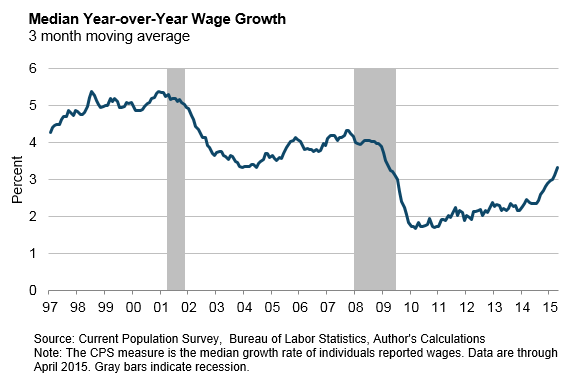Is the elusive US wage growth already here? First we had evidence from the Employment Cost Index and Labor Unit Costs. Then, we finally saw a tick up in the NFP’s Average Hourly Earnings, that broke out of range and showed +2.3% y/y in May.
New data from the Atlanta Fed, that recently came to light on its GDPNow track, shows that already in April, annual wage growth had accelerated to 3.3% y/y. Is the Fed already behind the curve?
Here is the chart showing the accelerated wage growth:

According to the institution led by Dennis Lockhart, this is an acceleration from 3.1% in March and the highest since March 2009. The pre-crisis peak was just above 4%. During the dot-com boom, wage growth peaked above 5%.
Wage inflation is the key driver of core inflation. The Federal Reserve focuses on core inflation and tends to ignore headline CPI that consists of the most volatile items, such as gasoline.
Wage growth occurs when labor markets are tightening – when there is a lack in slack. Is it already happening right now?
John Robertson in the Atlanta Fed points to a close and strong correlation between wage growth and the employment rate, with a lag of 12 months.
Lags between growth and employment are known. The Fed had a clear message: it is data dependent on rates. If the data improves, rate hikes will come sooner. If it disappoints, it will come later.
Janet Yellen and her peers would not like to choke the economy by raising rates too early. Having to hastily reverse such a move would also hurt their credibility and prevent proper handling of future crises.
But in their preference to be too late than too early, are the FOMC members already way too late? If this data and its correlations prove correct, the Fed should already raise rates in its upcoming June meeting.
However, the doves with the “better be late than early” approach probably have the upper hand, and September is more likely.
More: 3 positive takes on the NFP and 3 reasons NOT to hike in June
